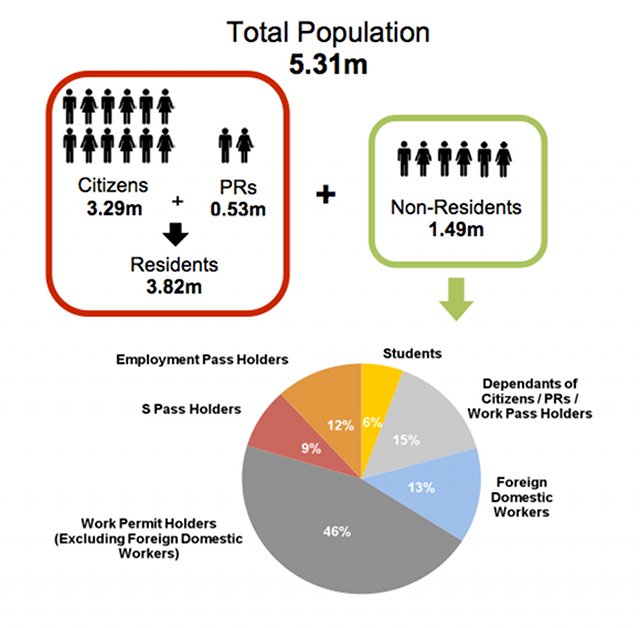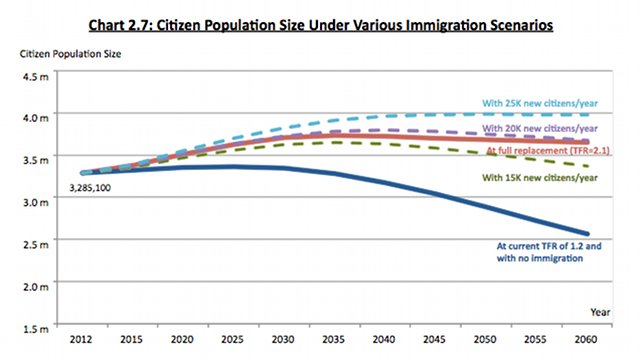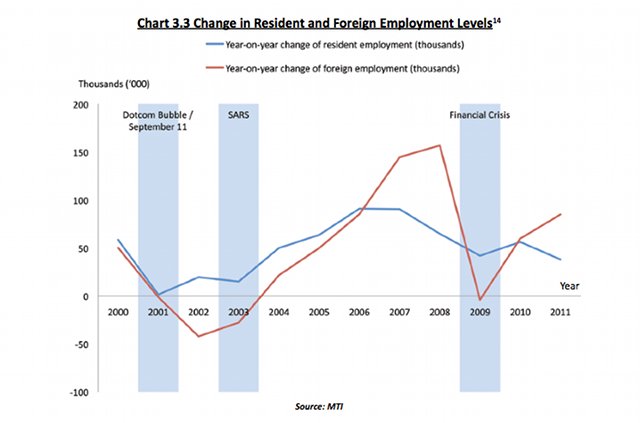SUMMARY
This is AI generated summarization, which may have errors. For context, always refer to the full article.

SINGAPORE – Not everyone was happy when the Philippines’ biggest fast-food chain, Jollibee, announced it would set up a store in Singapore.
An online group called “The Real Singapore” demanded a boycott of the chain, saying: “Singaporeans are encouraged to boycott Jollibee Singapore to send a message that foreign businesses which hire foreigners first are not welcome in Singapore.”
Despite the online resistance, the first store opened on March 12 in Lucky Plaza, a well-known hangout for Filipino immigrants. A month later, demand is still so great that even on weekdays lines, mostly of overseas Filipino workers, snake up to the door. The restaurant has had to maintain an empty room beside it just to hold additional waiting customers.
The store is a sign of the robust Filipino workforce in Singapore and the negative sentiment that it can sometimes give rise to among locals.
Worries among Singaporeans about the foreign workforce have not gone away. And the government is taking the concerns seriously and introducing stricter rules to limit the influx of workers from abroad.
The country’s Ministry of Manpower (MOM) is tightening some requirements for work passes, imposing higher levies on companies hiring foreign workers and lowering the maximum ratio of foreigners allowed in certain sectors.
READ: Foreign workers up in Singapore despite tightening
“It’s very difficult now. There are many companies who want to hire Filipinos but the problem is (getting) the work passes (for them),” the Philippine Ambassador to Singapore Minda Calaguian-Cruz told Rappler in Filipino in an interview Wednesday, April 3.
“It’s not focused on the Filipinos. It’s foreign talents as a whole and we’re just one part of that,” she added.
Liz Peruda, a customer service representative with an American technology company, said she is grateful her work pass application was approved. Her husband wasn’t as lucky. After his application was denied multiple times, he had to return to the Philippines to look for work.
“We’re just really taking advantage of whatever time we have here in Singapore,” said Peruda.
“For Filipinos, even if we hold a good job, even if we hold a high-ranking job, even us, we’re scared. When it’s time to renew our passes… we’ll have that 10% chance that it might not get approved,” she said.
What will change?
In a release from the MOM, the Singaporean government is introducing the following changes, to limit the inflow of foreign workers:
- By July 2013, the minimum qualifying salary for the S Pass, a work pass for mid-skilled foreigners, will be raised from SGD $2,000 to $2,200
- By July 1, 2015, Employers will have to begin paying a higher monthly levy for S Pass Holders, with the following average increases:
- S Pass (all sectors) – $90 per S Pass holder
- Manufacturing – $50 per Work Permit holder
- Services – $90 per Work Permit holder
- Construction- $160 per Work Permit holder
- The Dependency Ratio Ceiling (DRC), the maximum permitted ratio of foreign workers to the total workforce of a company, will be lowered as follows:
- Services sector DRC – limited to 40% from 45% by July 1, 2013
- S Pass sub-DRC for Services – decreased to 15% from 20% by July 1, 2013
- Marine Sector DRC – lowered from 1 local: 5 foreign workers currently to 1 local: 4.5 foreign workers starting January 1, 2016 and 1 local: 3.5 foreign workers effective January 1, 2018
Restrictions on the renewal of applications will also become more severe.
The government has become more strict about employment requirements for foreigners in recent years. It also tightened up on the number of permanent residence (PR) visas it gives out. Government record shows that from a high of 79,000 PRs in 2008, the government now grants about 30,000 each year.
The tightening in foreign employment criteria has been introduced to soothe local fears that foreigners are depressing wages, taking jobs that could go to Singaporeans, straining infrastructure and causing housing prices to shoot up.

In February, an anti-immigration protest rallied together an estimated 4,000 Singaporeans, one of the biggest political protests since the country gained independence, Bloomberg reported.
The protest came on the heels of a plan to increase the population through immigration, which the government described in the population white paper “A sustainable population for a dynamic Singapore.”

In the paper, the ruling Peoples’ Action Party (PAP) admitted that foreigners would be needed to help sustain economic growth, since without immigrants the population is expected to decrease.
The paper proposed hitting the following population parameters:
- 2012 – A total population of 5.31 million comprised of 3.82 million residents (of which 3.29 million are citizens) and 1.49 million non-residents
- 2020 – A total population of 5.8 to 6 million total comprised of 4 to 4.1 million residents (of which 3.5 to 3.6 million are citizens) and according to Rappler’s calculation 1.7 to 2 million are non-residents
- 2030 – A total population of 6.5 to 6.9 million comprised of 4.2 to 4.4 million residents (of which 3.6 to 3.8 million are citizens) and according to Rappler’s calculation 2.3 to 2.7 million are non-residents
According to Rappler’s calculations, the guidelines in the paper would mean increasing the number of non-residents by 81,000 to 1.21 million to help reach a population of 6.5 to 6.9 million in 2030.
“When the number 6.9 million was put into the public discourse, [Singaporeans] were shocked,” explained Arun Mahizhnan, a Special Research Adviser at the National University of Singapore’s Institute of Policy Studies.
“It is not that they don’t want any immigrants, it’s how fast are they allowed (in),” he said. As of 2012, non-residents made up 28% of the population. If the guidelines in the white paper are met, Rappler calculations show that the non-resident population could reach anywhere between 35% to 39% of the general population by 2030.

“It’s important to understand this entire problem in the context in which it is worrying Singaporeans. That is that Singaporeans must come first, and if they’re unable or unwilling then it is okay to bring in foreigners,” said Mahizhnan.
The new limits on foreign workers show that the PAP, which has ruled Singapore for more than 5 decades, is listening to the people.
READ: Singapore ruling party needs to reconnect: analysts
The PAP has been under more pressure to respond to populist concerns since recording its worst ever general election result in 2011, when it took only 60.1% of the popular vote and the number of opposition members in parliament tripled.
“The election was a watershed election because it gave expression to a number of these kind of simmering issues. But this (immigration) issue has been on the boiler for about 5 years, because that’s when the rate of increase had [reached] what many people think is (an) unacceptable level,” said Mahizhnan.
“I think government is serious in addressing these concerns of their public. And it so happens that as they address too the concerns of their public some too will be affected in the process. So employment is affected and that also includes our own nationals,” Calaguian-Cruz said.
“Any government, I think, in its right mind will always have to take a look at what its people say and what it’s people may perceive and this needs to be addressed,” she added. – Rappler.com
Add a comment
How does this make you feel?
There are no comments yet. Add your comment to start the conversation.